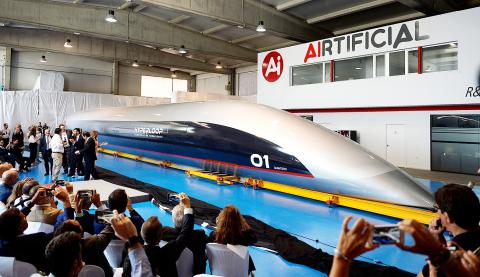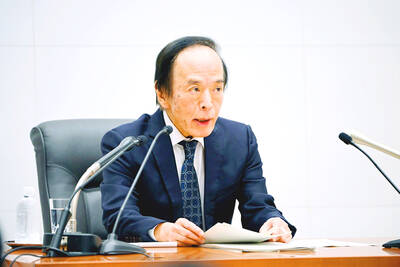Predicting the future is hard, even for the people with the most power to influence it. In 2013, Amazon.com Inc chief executive officer Jeff Bezos said he expected the company would be delivering packages by drone in four to five years. Here we are, seven years later, the flying delivery robots Bezos envisioned are still at the testing stage and have just started to get regulatory approval in the US.
Corporate fortune-telling is a common practice in the technology industry, and executives tend to choose round numbers as deadlines for their technological fantasies. So, as this year draws to a close and we approach a new decade, let us take a look back at how some of the tech industry’s predictions for next year fared:
Computer chips will consume almost no energy

Photo: AFP
Gordon Moore was famous for his foresight about the development of cheaper and more advanced computers. Intel Corp, the company he cofounded, stayed in the prognostication game years after Moore retired, with mixed results.
In 2012, Intel predicted a form of ubiquitous computing that would consume almost zero energy by next year.
The date is almost here, and smartphones still barely last a day before needing a recharge. The i9, Intel’s latest top-of-the-line computer chip, requires 165 watts of energy. That is more than twice as much as a 65-inch television.
Nine out of 10 people over six will own a mobile phone
In 2014, Ericsson Mobility estimated that 90 percent of people on Earth over six years old would own a mobile phone by next year.
This is a hard one to measure, but a visit to developing countries suggests we are nowhere close.
Research firm Statista GmbH puts global penetration at 67 percent.
One milestone achieved this decade is the number of mobile subscriptions exceeded the world’s population for the first time, according to data compiled by the World Bank.
The statistic is skewed by people who use multiple devices. Concern about the potential harmful effects of video game and social-media overuse by children might mean this never happens.
Jet.com will break even
Jet.com Inc was an embodiment of the start-up unicorn, before that was even a term.
Marc Lore started the online retailer after selling his previous company to Amazon. Jet would challenge Lore’s former employer by offering cheaper prices on products with a subscription that substantially undercut Amazon Prime.
To do that, Jet quickly started burning through the more than US$700 million it had raised from venture capitalists, and critics said the start-up had no path to profitability.
In response, Lore said on Bloomberg TV in 2015 that Jet would break even by next year. Walmart Inc swooped in a year after that interview and bought Jet for US$3.3 billion. According to news site Vox, Walmart is projecting a loss of more than US$1 billion this year for its US e-commerce division, now led by Lore.
The first 100km hyperloop ride will take place
In 2013, Elon Musk outlined his vision for a new “fifth mode of transportation” that would involve zipping people through tubes at speeds as fast as 1,290kph. Several tech entrepreneurs heeded Musk’s call and went to work on such systems inspired by the billionaire’s specifications.
In 2015, one of the leading start-ups predicted a hyperloop spanning about 100km would be ready for human transport by next year. Rob Lloyd, then-chief executive officer of Hyperloop Transportation Technologies, told Popular Science: “I’m very confident that’s going to happen.” It has not.
Google’s cloud business will eclipse advertising
Selling cloud services became a big business for Amazon, Alibaba Group Holding Ltd (阿里巴巴) and Microsoft Corp over the past decade. Google executive Urs Holzle saw the shift coming and in 2015 predicted that Google’s cloud revenue would supersede advertising by next year.
Alphabet Inc’s Google has inched closer to Amazon Web Services since then, but it would take a lot to outgrow Google’s cash cow. The cloud is expected to represent almost 15 percent of revenue for Google this year, compared with 85 percent for ads.
Huawei will make a ‘superphone’
Here is what Huawei Technologies Co Ltd (華為) said in 2015 predicting a “superphone” by next year, according to ZDNet: “Inspired by the biological evolution, the mobile phone we currently know will come to life as the superphone,” strategy marketing president Shao Yang (邵洋) said.
“Through evolution and adaptation, the superphone will be more intelligent, enhancing and even transforming our perceptions, enabling humans to go further than ever before,” Shao said.
It is not entirely clear what that means, but it probably has not happened yet. In the interim, Huawei found itself in the middle of a trade dispute, and the Chinese company is focusing largely on mid-priced smartphones for its domestic market.
Toyota will make fully self-driving cars
Auto and tech companies alike became convinced this decade that computers would soon be able to drive vehicles more reliably than people. In 2015, Toyota Motor Corp made a company-wide bet that it would have autonomous highway-driving vehicles on the road by next year.
It did not take long for the hype cycle to veer off course. Last year, a pedestrian died after colliding with an Uber Technologies Inc self-driving vehicle.
Next year, Toyota’s Lexus brand is to introduce a car capable of driving autonomously on the highway, but executives acknowledged that auto companies “are revising their timeline for AI [artificial intelligence] deployment significantly.”
A Bitcoin will be worth US$1 million
John McAfee, the controversial computer antivirus mogul and an influential voice in the cryptocurrency community, predicted that the price of bitcoin would reach US$1 million by the end of next year.
McAfee posted the estimate in November 2017, about three weeks before a crash would erase 83 percent of value over the next year. Bitcoin has recovered somewhat, but the current price of about US$7,200 is far from McAfee’s magic number. Like other bitcoin bulls, McAfee is standing by his unlikely prediction. If he is wrong, McAfee said he would eat an intimate body part.
Dyson will sell an electric car
It was barely two years ago when the maker of blow-dryers and vacuum cleaners said it would sell an electric car by next year. Dyson Ltd canceled the project this year, calling it “not commercially viable.”
Uber will deploy flying cars
When Uber pledged to deliver on a promise of the Jetsons, it gave itself just three years to do so.
It is safe to say that you will not be able to hail a flying Uber in the next year.
The company continues to explore the concept with regulators. This year, Uber added a form of flying vehicle that is not particularly cutting edge: It is booking helicopter rides in New York City.
On Friday last week, Uber said it was working with a start-up, Joby Aviation, to develop “aerial ride-sharing” and set a new deadline of 2023. Uber chief executive officer Dara Khosrowshahi said on Twitter: “Getting closer...”
With assistance from Ian King

Taiwan’s long-term economic competitiveness will hinge not only on national champions like Taiwan Semiconductor Manufacturing Co. (TSMC, 台積電) but also on the widespread adoption of artificial intelligence (AI) and other emerging technologies, a US-based scholar has said. At a lecture in Taipei on Tuesday, Jeffrey Ding, assistant professor of political science at the George Washington University and author of "Technology and the Rise of Great Powers," argued that historical experience shows that general-purpose technologies (GPTs) — such as electricity, computers and now AI — shape long-term economic advantages through their diffusion across the broader economy. "What really matters is not who pioneers

In a high-security Shenzhen laboratory, Chinese scientists have built what Washington has spent years trying to prevent: a prototype of a machine capable of producing the cutting-edge semiconductor chips that power artificial intelligence (AI), smartphones and weapons central to Western military dominance, Reuters has learned. Completed early this year and undergoing testing, the prototype fills nearly an entire factory floor. It was built by a team of former engineers from Dutch semiconductor giant ASML who reverse-engineered the company’s extreme ultraviolet lithography (EUV) machines, according to two people with knowledge of the project. EUV machines sit at the heart of a technological Cold

TAIWAN VALUE CHAIN: Foxtron is to fully own Luxgen following the transaction and it plans to launch a new electric model, the Foxtron Bria, in Taiwan next year Yulon Motor Co (裕隆汽車) yesterday said that its board of directors approved the disposal of its electric vehicle (EV) unit, Luxgen Motor Co (納智捷汽車), to Foxtron Vehicle Technologies Co (鴻華先進) for NT$787.6 million (US$24.98 million). Foxtron, a half-half joint venture between Yulon affiliate Hua-Chuang Automobile Information Technical Center Co (華創車電) and Hon Hai Precision Industry Co (鴻海精密), expects to wrap up the deal in the first quarter of next year. Foxtron would fully own Luxgen following the transaction, including five car distributing companies, outlets and all employees. The deal is subject to the approval of the Fair Trade Commission, Foxtron said. “Foxtron will be

INFLATION CONSIDERATION: The BOJ governor said that it would ‘keep making appropriate decisions’ and would adjust depending on the economy and prices The Bank of Japan (BOJ) yesterday raised its benchmark interest rate to the highest in 30 years and said more increases are in the pipeline if conditions allow, in a sign of growing conviction that it can attain the stable inflation target it has pursued for more than a decade. Bank of Japan Governor Kazuo Ueda’s policy board increased the rate by 0.2 percentage points to 0.75 percent, in a unanimous decision, the bank said in a statement. The central bank cited the rising likelihood of its economic outlook being realized. The rate change was expected by all 50 economists surveyed by Bloomberg. The